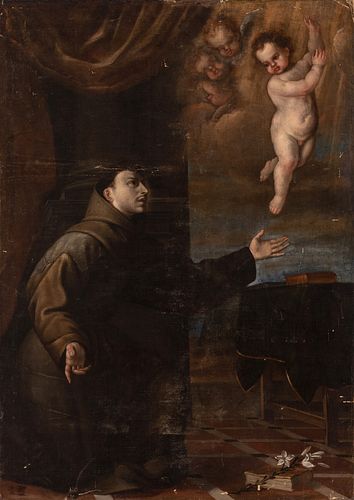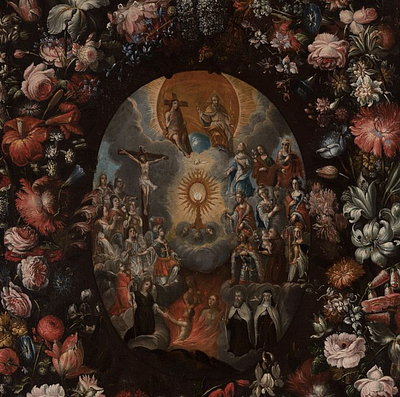Andalusian School; first half of the seventeenth century. "Saint Anthony of Padua". Oil on canvas. Re-drawn.
Lot 94
About Seller
Setdart Auction House
Carrer Aragó 346
Barcelona
Spain
Setdart Subastas was born in 2004 and is currently the first online art auction in Spain with solidity, prestige and reliability guaranteed by our more than 60,000 users. Setdart has a young, dynamic and enterprising team ready to successfully manage the purchase and sale of art works through custom...Read more
Estimate:
EUR€3,000 - EUR€4,000
$3,225.81 - $4,301.08
Absentee vs Live bid
Two ways to bid:
- Leave a max absentee bid and the platform will bid on your behalf up to your maximum bid during the live auction.
- Bid live during the auction and your bids will be submitted real-time to the auctioneer.
Bid Increments
| Price | Bid Increment |
|---|---|
| EUR€0 | EUR€10 |
| EUR€200 | EUR€25 |
| EUR€500 | EUR€50 |
| EUR€1,000 | EUR€100 |
| EUR€3,000 | EUR€200 |
| EUR€5,000 | EUR€500 |
| EUR€10,000 | EUR€1,000 |
| EUR€20,000 | EUR€2,000 |
| EUR€50,000 | EUR€5,000 |
About Auction
By Setdart Auction House
Jul 14, 2021
Set Reminder
2021-07-14 06:30:00
2021-07-14 06:30:00
America/New_York
Bidsquare
Bidsquare : OLD MASTERS
https://www.bidsquare.com/auctions/setdart-auction-house/old-masters-7202
Setdart Auction House sofia@setdart.com
Setdart Auction House sofia@setdart.com
- Lot Description
Andalusian School; first half of the seventeenth century. "Saint Anthony of Padua". Oil on canvas. Re-drawn. It presents damages. Size: 205 x 245 cm. Oil on canvas of devotional character, representing St. Anthony of Padua and the Child Jesus. In front of the saint, kneeling and dressed with habit, we see the Child Jesus floating in the sky, on a bottom in which a golden break of glory is appreciated, looking directly to the saint. The position of both characters is typically baroque: the saint opens his hands in a sign of acceptance, while he humbly bows his face without ceasing to look at the Child. The latter, on the other hand, presents an opposite position, with a typically baroque ascending rotating movement, which is contrasted by the head bent downwards to look at the saint. St. Anthony of Padua is, after St. Francis of Assisi, the most popular of the Franciscan saints. He was born in Lisbon in 1195 and only spent the last two years of his life in Padua. After studying at the convent of Santa Cruz in Coimbra, in 1220 he entered the Order of Friars Minor, where he changed his first name, Fernando, to Antonio. After teaching theology in Bologna, he traveled through southern and central France, preaching in Arles, Montpellier, Puy, Limoges and Bourges. In 1227 he participated in the general chapter of Assisi. In 1230 he was in charge of the transfer of the remains of St. Francis. He preached in Padua and died there at the age of 36 in 1231. He was canonized only a year after his death, in 1232. Until the end of the 15th century, the cult of St. Anthony remained located in Padua. From the following century he became, at first, the national saint of the Portuguese, who put under his patronage the churches they built abroad, and then a universal saint. He is represented as a beardless young man with a large monastic tonsure, dressed in the brown habit of the Franciscans. One of his most frequent attributes is the book, which identifies him as a sacred writer. Another distinctive iconographic feature is the branch of lily, an element taken from his panegyrist Bernardino de Siena. St. Anthony is usually presented with the Child Jesus, in allusion to an apparition he had in his cell. It became the most popular attribute of this saint from the 16th century onwards, being especially popular in the Baroque art of the Counter-Reformation. The 17th century marked the arrival of the Baroque in the Andalusian school, with the triumph of naturalism over Mannerist idealism, loose workmanship and many other aesthetic liberties. At this time the school reached its greatest splendor, both for the quality of the works and for the primordial rank of Sevillian Baroque painting. Thus, during the transition to Baroque we find Juan del Castillo, Antonio Mohedano and Francisco Herrera el Viejo, in whose works the rapid brushstroke and the crude realism of the style is already manifested, and Juan de Roelas, introducer of Venetian colorism. In the middle of the century the period reached its peak, with figures such as Zurbarán, a young Alonso Cano and Velázquez. Finally, in the last third of the century we find Murillo and Valdés Leal, founders in 1660 of an Academy where many of the painters active during the first quarter of the 18th century were trained, such as Meneses Osorio, Sebastián Gómez, Lucas Valdés and others.
- Shipping Info
-
In-house shipping available. Please inquire at admin@setdart.com.
-
- Buyer's Premium



 EUR
EUR CAD
CAD AUD
AUD GBP
GBP MXN
MXN HKD
HKD CNY
CNY MYR
MYR SEK
SEK SGD
SGD CHF
CHF THB
THB













